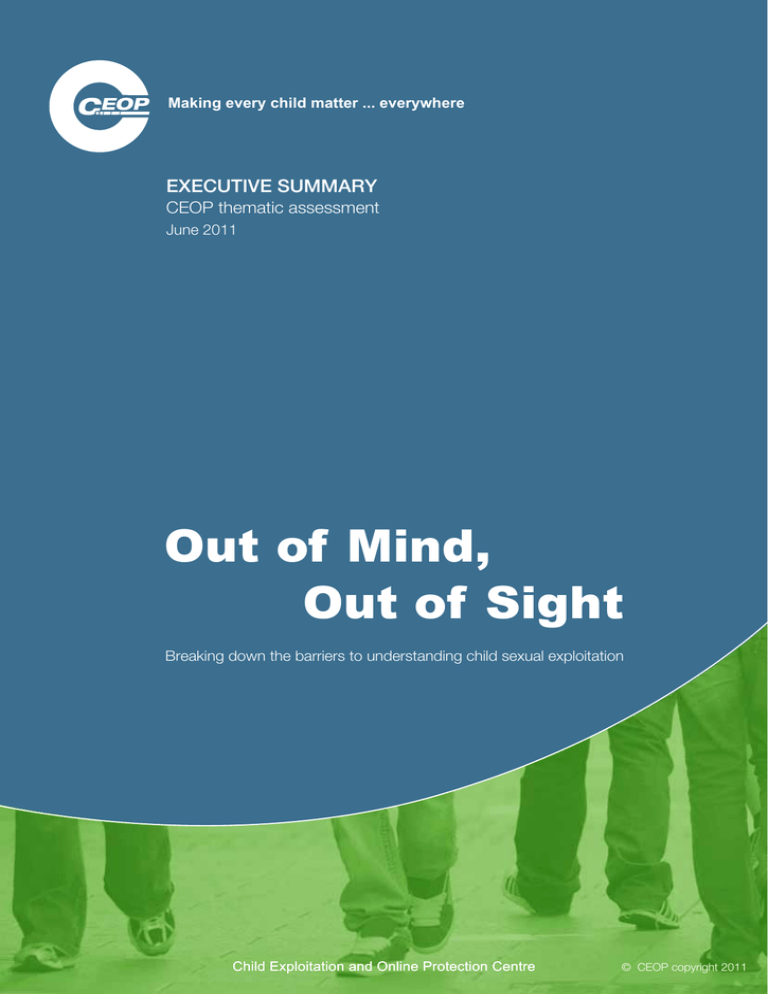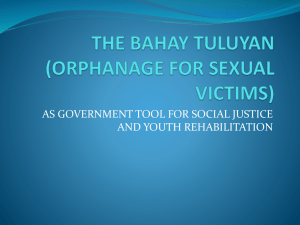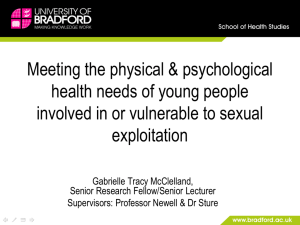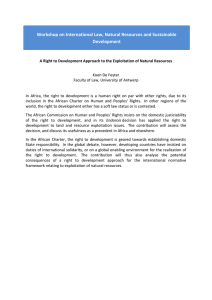
Making every child matter ... everywhere
EXECUTIVE SUMMARY
CEOP thematic assessment
June 2011
Out of Mind,
Out of Sight
Breaking down the barriers to understanding child sexual exploitation
Child Exploitation and Online Protection Centre
© CEOP copyright 2011
Breaking down the barriers to understanding child sexual exploitation
Executive summary – CEOP thematic assessment
cONTENTS
Foreword
5
Introduction
7
8
Conclusions 15
Recommendations
16
Glossary
18
Findings
The full report is available on ceop.police.uk
3
Child Exploitation and Online Protection Centre
Executive summary – CEOP thematic assessment
Foreword
The sexual exploitation of children is child abuse. Often it involves rape. It is
premeditated, planned and carried out systematically with a complete lack of
respect or empathy for the victims; indeed the victims are often singled out for
their vulnerability.
The Child Exploitation and Online Protection (CEOP) Centre is publishing this thematic
assessment to increase people’s understanding of this appalling crime. I believe that
government, communities, agencies, charities and others will – with the benefit and
burden of knowledge – work with a passion to prevent child sexual exploitation,
protect victims and the vulnerable, and pursue the perpetrators.
This assessment has scoured the UK, from academia to front line police officers and the victims themselves, to identify
definitively what can currently be known, draw conclusions from it and make recommendations that, we think, are most
likely to improve what is an unacceptable situation. However, protecting children is not a job for us alone; it is the duty
of many. I hope that others will reflect on our findings and challenge themselves to come up with their own solutions
and contributions.
Doing the best thing for children requires us to deal with the information objectively. Anything less will distort people’s
perception of the threat, reducing the prospect of effective solutions being developed, and distracting potential victims
from the real sources and indicators of risk. We must be mature enough to conduct public debate with humility,
thoughtfulness and balance, and passionate enough to change what we do if that is what makes children safer.
Peter Davies
Chief Executive Officer
Child Exploitation and Online Protection Centre
5
Executive summary – CEOP thematic assessment
INTRODUCTION
In January 2011, the Child Exploitation and Online Protection (CEOP) Centre announced it would carry out a thematic
assessment of the phenomenon known as ‘localised grooming’1. ‘Localised grooming’ has been the subject of
considerable media attention, following the prosecutions of adult males for the grooming and sexual exploitation
of children and young people in various towns and cities in the UK.
The purpose of the assessment was to establish whether it was possible to identify any patterns of offending,
victimisation, or vulnerability and draw lessons for future action.
This thematic assessment was undertaken with four principle objectives:
ÜAssess the size and scale of ‘localised grooming’ in proportion to the overall known picture of sexual exploitation
of children in the UK.
Ü
Establish any patterns of offending profile or victim experience.
ÜAssess the effectiveness of processes which might help identify such offending or potential victims.
ÜRecommend action to be taken to reduce the risk in future, including any urgent action that becomes apparent.
This short report summarises the findings, conclusions and recommendations of the full assessment. The assessment
can be found on the CEOP website at www.ceop.police.uk
This report provides an outline of trends, themes and patterns based on an intensive six month period of research into
child sexual exploitation. It acknowledges the challenges faced by agencies working with victims of child sexual abuse,
but also identifies serious weaknesses and makes recommendations to improve practice in safeguarding victims and
improving criminal justice outcomes.
The aim is to improve the depth of understanding among police forces, children’s services, local safeguarding children
boards (LSCBs) and service providers. CEOP is committed to working with these agencies and stakeholders to ensure
that the findings and recommendations of this thematic assessment are understood, implemented and followed.
}}What most people don’t realise
is that it scars you for life. It still
||
affects you years later
Young victim
‘Localised grooming’ is a form of sexual exploitation – previously referred to as ‘on street grooming’ in the media - where children have been groomed
and sexually exploited by an offender, having initially met in a location outside their home. This location is usually in public, such as a park, cinema, on
the street or at a friend’s house. Offenders often act together, establishing a relationship with a child or children before sexually exploiting them. Some
victims of ‘street grooming’ may believe that the offender is in fact an older ‘boyfriend’; these victims introduce their peers to the offender group who
might then go on to be sexually exploited as well. Abuse may occur at a number of locations within a region and on several occasions. ‘Localised
grooming’ was the term used by CEOP in the intelligence requests issued to police forces and other service agencies in order to define the data we
wished to receive.
1
7
Out of Mind, Out of Sight Breaking down the barriers to understanding child sexual exploitation
FINDINGS
1
Assess the size and scale of ‘localised grooming’ in proportion to the overall known picture
of sexual exploitation of children in the UK.
This assessment was designed to assess the scale of ‘localised grooming’. Unfortunately, CEOP received a limited
response from agencies, especially children’s services and LSCBs. In total, only 13 LSCBs responded to the request
for information2. The highest response was from police forces but a significant number of forces reported a nil return.
The data is significantly weighted towards the relatively limited number of areas who have provided a comprehensive
response. These areas generally have stronger partnership arrangements to address child sexual exploitation.
The data submitted refers only to the ‘localised grooming’ model of child sexual exploitation and does not include online
grooming, trafficking of children into the UK, peer-on-peer abuse or other forms of sexual exploitation. It has proven
impossible, however, to neatly segment localised grooming from other forms due to the complexities and overlap within
the offending behaviour.
This assessment cannot be seen as fully representative of the nature and scale of child sexual exploitation in the U.K.,
or, indeed, of the ‘localised grooming’ model. Data relating to child sexual exploitation is often partial and incomplete,
concealed in secondary indicator data, or simply unrecorded.
In many cases, agencies do not have any data on child sexual exploitation. Indications from service providers suggest
that because victims frequently do not recognise that they are being exploited and do not disclose abuse, there is
significant unidentified and unmet need.
Where police, children’s services and voluntary sector agencies have worked together, coordinated by the LSCBs, to
identify and address child sexual exploitation, a significant number of cases have come to light. However, very few cases
are known in areas where agencies do not routinely engage victims and collect data. Agencies which do not proactively
look for child sexual exploitation will as a result fail to identify it. As a result, the majority of incidents of child sexual
exploitation in the UK are unrecognised and unknown.
}}You’re lucky if you can tell
your mum. Some people
can’t
Young victim
Overall there were nine responses from children’s services, nine joint responses from children’s services and LSCBs and four responses
from LSCBs alone.
2
8
||
Executive summary – CEOP thematic assessment
FINDINGS
2
Establish any patterns of offending profile or victim experience.
Offender data
2,379 individuals were reported to CEOP as being possible offenders in relation to street grooming and child sexual
exploitation. 1,162 individuals were excluded from analysis due to a lack of any basic information about them. The
remaining data was divided into two groups, according to the level and quality of information available. This information
is sometimes based on a custody record where the precision of the record appears reliable, or on details provided by
a victim where no offender has been identified. In some cases, this information was derived from the Police National
Computer (PNC).
Group one consisted of 940 individuals for whom a full name or initials were recorded. Group two consisted of 277
individuals for whom only a given name or alias was available. The level of detailed information associated with
individuals in group one is much higher than that in group two3. Unfortunately, there are likely to be gaps and errors
in both groups.
When groups one and two (1,217 offenders) were analysed, despite the variable data quality, the results show that
the vast majority are men, with 87% males, 4% females, and 9% unknown. They also show that the offenders are
disproportionately skewed towards young adults within the 18-24 age range, with almost half of the offenders being
under 25 where their age is known. The relative youth of the offender population is a striking feature of the data that
is distinct from a common profile of the older male abuser.
Caution should be taken in drawing conclusions about ethnicity due to the relatively small number of areas where
agencies have been proactive around this particular type of crime. We do not draw national conclusions about ethnicity
from the data available at this time because it is too inconsistent. Further research would be needed to examine whether
the ethnic breakdown reflects issues that need to be addressed within a community context, local demographics
of the areas from which data is drawn, an unconscious bias among agency responses or other factors that need
to be explored.
In relation to ethnicity, the data was often recorded to a particularly poor standard at the point of capture. ‘Ethnicity’ was
often conflated with ‘nationality’ and neither factor captured according to a conventional or standardised classification
scheme. Within the available dataset there was a significant difference between the groups. For groups one and two
combined, the ethnicity of 38% of the offenders was unknown, 30% were white, 28% Asian4, 3% Black and 0.16%
Chinese. When only group one was analysed, the offenders were found to be 38% white, 32% unknown, 26% Asian,
3% Black, and 0.2% Chinese.
Many of the cases submitted for assessment were incomplete and had significant intelligence gaps. This was particularly apparent in information
relating to offenders. In some cases, there was no information provided at all relating to offenders and the respondent was only able to state that a child
had disclosed that they had been groomed and sexually exploited.
3
Unfortunately, due to the sources from which data has been drawn it has not been possible to identify or distinguish the nationality, as opposed to an
ethnicity that has been given for offenders. The ‘Asian’ numbers may therefore comprise, for example, Pakistani or Bangladeshi nationals alongside
British Asians of different ethnic origins. Further and more differentiated breakdowns within the broad groups are presented in the full report.
4
9
Out of Mind, Out of Sight Breaking down the barriers to understanding child sexual exploitation
FINDINGS
Offender behaviour
The cases submitted to CEOP identified 230 networks of offenders ranging in size from just two offenders to much
larger groups, the full extent of which was not known. Some offenders were core network members, responsible for
identifying and grooming victims for exploitation by a group of their friends and associates. Other offenders were more
peripheral members of a network, less heavily involved and more opportunistic in their activity.
Many of the detailed cases submitted to CEOP showed that grooming is used to manipulate victims, distance them
from families and friends, and place them under the control of the offender. Offenders will often use flattery and attention
to persuade victims to view them as a ‘boyfriend’.
Many offenders appeared to derive satisfaction from exerting control over victims through coercive and manipulative
behaviour, not only to commit sexual offences, but also as an end in itself. In this respect the offender psychology
appears to bear a resemblance to perpetrators of domestic abuse. Further debriefing of offenders is needed to gain
a better understanding of this.
Victim data
2,083 victims of child sexual exploitation were reported to CEOP. The vast majority of victims in the dataset are female,
although, in 31% of cases, the gender of the victim was unknown. Although the majority of victims in the dataset are
female, difficulties in recognising sexual exploitation among boys and young men are likely to have led to an underrepresentation of male victims.
The most common ages at which a child comes to the attention of statutory or non-statutory agencies are 14 and 15.
The data found that victims were from a range of ethnicities although the majority were white. Among the 2,083 victims,
61% are white, 33% are unknown, 3% Asian, and 1% Black. Research suggests that minority ethnic groups are likely
to be under-represented due to additional barriers they face in reporting and accessing mainstream services5.
For most cases in the dataset information about whether the victim had gone missing was not known, but out of the
1,014 cases where information on this was recorded, 842 children were known to have been reported missing on at
least one occasion. Unfortunately, the data does not show whether these missing incidents fell before, during, or after
the period of exploitation. Of the 896 children in the dataset whose living situation was known, 311 were already in care
at the time of the exploitation and a further 43 children were moved into care following intervention.
}}People’s stereotype is ‘girls like
||
that’, that’s what they do
Young victim
See for example, Ward, J and Patel, N 2006 ‘Broadening the discussion on sexual exploitation; ethnicity, sexual exploitation and young people’,
Child Abuse Review, 15, 341 – 350.
5
10
Executive summary – CEOP thematic assessment
FINDINGS
Victim experience
Victims have a range of different vulnerabilities but there are some common themes that emerge from the data:
Ü
as identified in the dataset, sexually exploited children frequently go missing from home or run away for varying
periods of time. Similarly, as identified in the data, many victims were reported to be in the looked-after system
before or during exploitation;
Ü
from the data, where information relating to school engagement was known, the majority of victims were
disengaged from school. This was manifested in truanting, a lack of interest and frequent poor behaviour,
including bullying peers. Many victims were also themselves victims of bullying;
Ü
victims in the dataset exhibited a number of signs of having been exploited. These indicators include injuries as
a result of physical/sexual assault during the exploitation and problematic sexual behaviour, including unwanted
pregnancies and STIs; and
Ü
the chaotic and at times, aggressive behaviour of some victims, meant they were perceived to be a risk to other
children by the police and social services.
The vulnerability of many victims renders them particularly susceptible to the grooming tactics employed by
perpetrators. All victims in the dataset had been groomed to some extent by their exploiter with a variety of coercive
tactics used to control them and keep them in exploitative situations:
Ü
many victims feared that their exploiter would be violent towards them should they fail to comply with their
demands or if they were to cooperate with the police;
Ü
offenders use one victim to gain access to others, asking victims about their friends and encouraging them to
bring their friends to pre-arranged meetings. If a victim attempts to steer away from risky situations, offenders
can use their peers to pull them back in;
Ü
a common experience among victims was the disorientating effect of being moved by the offender around and
between large towns. Victims were often targeted by perpetrators in public places, including town or city centres
(particularly shops, restaurants and takeaways) and local parks. After initial meetings with offenders, a number of
different types of location were used for sexual exploitation. Taxi firms have been implicated in a number of cases
and offenders were reported to have picked victims up from near their homes, on the street or from parks and
driven them to other locations; and
Ü
offenders often deliberately create and/or exacerbate vulnerabilities that victims have, such as disengagement
from their families or family difficulties, detachment from services, or challenging or criminal behaviour. This is
so that they can retain exclusive control over the young person.
Overall, victims are unlikely to disclose exploitation voluntarily, as a result of fear of exploiters, loyalty to perpetrators,
a failure to recognise that they have been exploited and a negative perception or fear of authorities.
Agencies involved in identifying and safeguarding sexually exploited children and young people, including the police,
must recognise that victims are unlikely to present as victims of a sexual offence and are likely to be hostile to
engagement. Agencies must be aware that the length of time between incidents of exploitation and disclosure
to the authorities is not a symptom of unreliability, but a direct result of exploitation.
11
Out of Mind, Out of Sight Breaking down the barriers to understanding child sexual exploitation
FINDINGS
Our analysis supports the risk assessment tools contained in statutory guidance6. These should be used by front line
services to identify children who are being exploited. A range of different factors are highlighted as potential indicators.
For example:
Ü
adults or older youths loitering outside the child’s usual place of residence;
Ü
persistently missing, staying out overnight or returning late with no plausible explanation;
Ü
leaving home/care setting in clothing unusual for the individual child (inappropriate for age, borrowing clothing
from older young people);
Ü
acquisition of expensive clothes, mobile phones or other possessions without plausible explanation;
Ü
truancy/disengagement with education or considerable change in performance at school;
Ü
volatile behaviour exhibiting extreme array of mood swings or use of abusive language;
Ü
getting involved in petty crime such as shoplifting, stealing;
Ü
entering or leaving vehicles driven by unknown adults;
Ü
hostility in relationship with parents/carers and other family members; and
Ü
returning after having been missing, looking well cared for in spite of having no known home base.
}}If you’ve got a hard family life
you don’t want to put more
stress on your parents, you
might not know how your
||
parents would react
Young victim
A full risk assessment tool can be found in DCSF (2009) guidance ‘Safeguarding children and young people from sexual exploitation’.
6
12
Executive summary – CEOP thematic assessment
FINDINGS
3
Assess the effectiveness of processes which might help identify such offending or
potential victims.
Multi-agency working
Front line workers within the police, children’s services, and the voluntary sector consistently stated that multi-agency
working is essential to tackling child sexual exploitation. National guidance states LSCBs should ensure specific
procedures are in place, setting out the roles and responsibilities of local agencies and professionals; should identify
sub-group to lead on child sexual exploitation; and should establish lead professionals in each agency. It also
recommends the development of a multi-agency team.
However, recent research has shown that most LSCBs have not implemented key aspects of this guidance.
For example, approximately three quarters have not established a relevant sub group, most do not have a lead
professional, and most do not have up to date protocols7.
Front line awareness
Practitioners indicated a need for improved awareness of the signs and symptoms of child sexual exploitation across
a range of services. More work is needed to ensure that all agencies are able to identify sexual exploitation, support
children and escalate concerns. These agencies include sexual health clinics, child and adolescent mental health
services, GPs, youth workers, teachers in schools and in pupil referral units, school nurses, YOTs, specialist services
for homeless or drug abusing young people, as well as various police teams.
A greater understanding of the vulnerabilities and experiences of victims and the symptoms of abuse is needed to help
front line agencies develop a more tailored response to children who are likely to be particularly vulnerable.
Engagement with victims
Practitioners described the need for proactive outreach to engage successfully with victims. Police and social workers
reported difficulties with positively engaging victims of child sexual exploitation. Victims themselves reported negative
experiences of statutory services. Where the engagement was successful it was because workers had invested time
in building rapport with young people.
Voluntary sector agencies reported that they were successful in engaging victims of child sexual exploitation through
a sustained process of intensive outreach. Where voluntary sector agencies also worked in partnership, this led to more
successful outcomes, where the initial disclosure of exploitation to a project worker, could lead to a police investigation.
Jago, S et al. 2010 Interim Report: What’s going on to prevent child sexual exploitation, Luton: University of Bedfordshire.
7
13
Out of Mind, Out of Sight Breaking down the barriers to understanding child sexual exploitation
FINDINGS
Investigations and evidence
In general, children vulnerable to child sexual exploitation often fail to meet children’s services thresholds for intervention
because they are not seen as vulnerable, to the same extent as younger children and their exploitation is not
understood. In many cases, children will only receive an appropriate response if there is a specialist voluntary sector
provider available in the area.
Referrals of child sexual exploitation cases commonly fall outside the terms of reference for police Child Abuse
Investigation Units (CAIUs), which are generally mandated specifically to deal with cases of familial child abuse. Cases
of child sexual exploitation are often passed to CID teams which manage a diverse caseload and are often lacking in
the capacity and expertise to investigate them.
Police experience major challenges in compiling sufficient evidence to prosecute and convict perpetrators of child sexual
exploitation. Police recognise the need to improve the quality of their engagement with, and evidence gathering from,
victims in addition to their offender interview techniques.
Prosecutions and court proceedings
Police officers reported experiencing difficulties during prosecution and court proceedings. They reported that the
CPS solicitors are often reluctant to take up cases of child sexual exploitation because victims are often perceived
as unreliable. Victims may struggle to express their experiences and may be uncooperative and difficult to engage.
Police recommend working with a regular CPS solicitor who has a strong awareness and shared understanding of the
issues. This tends to result in successfully bringing cases of child sexual exploitation to court and securing convictions
of offenders.
Supporting victims during court proceedings is vital to the successful prosecution of a case. Victims find the court
processes traumatic and difficult, particularly the aggressive and intrusive line of questioning pursued by many defence
barristers. Practitioners emphasised that all agencies must work together to support victims and their families before,
during and after court appearances.
Engagement with victims must continue beyond the court process, with ongoing support to mitigate risk, which is not
dependent on the outcome of a court case. Children and young people in this situation may have multiple vulnerabilities
that need addressing and they may still remain at risk of sexual exploitation, even if the offender has been convicted.
Acquittal of the defendant is extremely distressing for victims, given the trauma of re-living experiences of exploitation
in court, only to feel that they have been judged to have been lying.
}}You feel judged because of
your background. They may not
||
believe you
14
Young victim
Executive summary – CEOP thematic assessment
CONCLUSIONS
Size and scale of the known picture
Where the police, children’s services and voluntary sector agencies have worked together to address child sexual
exploitation, victims have been identified and supported and offenders held to account. However, in most areas of the
UK, there does not appear to be a proactive approach to this issue. We find that the data collected in this assessment
is likely to represent only a small fraction of the full picture and is an inadequate basis for national findings.
Offending profile or victim experience
The offenders within our dataset are younger with almost half of them being under 25, where age is known. There is
a noticeable level of networking and particular behavioural characteristics among many offenders in that they appear
to derive satisfaction from the status and power of exerting control over victims, not only to commit sexual offences,
but also as an end in itself.
Victims often exhibit multiple vulnerabilities with going missing and living in care common features of their experience.
Vulnerabilities are deliberately exacerbated by offenders in the interests of retaining control.
The challenges for victims to break out of exploitation can be overwhelming. Victims find it difficult to disclose their
abuse and they need proactive engagement from workers to help and support them over the long-term. Investigative
and court processes can increase the pressure and distress experienced by victims.
Effectiveness of processes
Most LSCBs do not fulfil the pivotal role prescribed for them in statutory guidance in respect of child sexual exploitation.
All agencies need to improve their recognition of this abuse and exploitation, intervening with safeguarding activity at an
early stage. The need for a commitment to multi-agency work to tackle this issue encompasses all front line services.
15
Out of Mind, Out of Sight Breaking down the barriers to understanding child sexual exploitation
RECOMMENDATIONS
1
Victims
ÜVictims and their families should receive support from specialist services throughout the process of disclosure,
police investigations and court proceedings, until the risk of sexual exploitation is mitigated.
ÜVictims’ accounts and experiences should be used to inform agency responses both in designing prevention
messages and early interventions – through to the set up of specialist support.
2
Multi-agency working and front line services
ÜAll LSCBs must meet their responsibility under current guidance – Safeguarding Children and Young People from
Sexual Exploitation (DCSF, 2009) – and ensure that there is a coordinated multi-agency response to this issue
and clear and up to date procedures. Each LSCB must assume that sexual exploitation occurs in its area unless
there is clear evidence to the contrary.
Ü
LSCBs must ensure that children who are at risk can be identified at an early stage across a range of agencies
and that there are clear protocols for sharing information. They should ensure that children at risk have a full
assessment of their needs and referral to relevant services for intervention and support.
Ü
Given the links between sexual exploitation and other vulnerabilities, LSCBs must ensure that those working
with or in contact with children who are particularly vulnerable, understand the signs of exploitation and can refer
children for tailored support. There should be particular emphasis on foster carers and residential care staff, as
well as all front line workers that come into contact with missing children.
Ü
LSCBs should support the development of a specialist multi-agency team that can support vulnerable victims
as well as deterrence and prosecution activity.
Ü
LSCBs should ensure that there is sufficient specialist training for front line service providers so that they are
equipped to identify children at risk. Professionals should have an understanding of key indicators of exploitation
and that although many victims can present as ‘streetwise’, they are in fact highly vulnerable.
Ü
Each policing team that may come into contact with victims or offenders needs to have an understanding
of child sexual exploitation. Training should be provided to appropriate police units and teams, including CAIUs,
CID, PPUs and community policing. Police forces should also develop a strategy to ensure that cases of child
sexual exploitation are identified and progressed appropriately.
Ü
Children’s services must ensure that cases of child sexual exploitation are assessed and responded to
appropriately; this will require a thorough understanding of the impact on victims.
16
Executive summary – CEOP thematic assessment
RECOMMENDATIONS
3
Crown Prosecution Service (CPS)
ÜThe CPS should review all prosecutions in child sexual exploitation to identify barriers to taking cases forward,
and outline best practice in relation to the support available for victims. The CPS should also review recent
cases to identify key aspects of the investigation and criminal justice process that can lead to successful
prosecution outcomes.
4
Data recording
ÜAll front line agencies should develop ways of capturing and recording data relating to known or suspected
cases of sexual exploitation. LSCBs should coordinate the development of a template for capturing information
which is of use to both police and services for sexually exploited children.
Ü
Police forces should proactively gather intelligence and develop regular problem profiles of child sexual
exploitation.
5
Research
ÜThis assessment has identified many significant gaps in current knowledge of child sexual exploitation.
Key areas for further research and analysis are outlined in the full assessment.
}}What most people don’t realise
is that it scars you for life. It still
||
affects you years later
Young victim
17
Out of Mind, Out of Sight Breaking down the barriers to understanding child sexual exploitation
Glossary
ABE
CAIU Achieving Best Evidence
Child Abuse Investigation Unit
Children’s Services Children’s Services Departments in local authorities develop, commission and lead the delivery
of services to children and young people, including education, health, youth, early years and social
care services
CID
Criminal Investigation Department
CPS Crown Prosecution Service. The Crown Prosecution Service is the Government Department
responsible for prosecuting criminal cases investigated by the police in England and Wales
DCSF
Department for Children, Schools and Families. A government department, renamed Department
for Education in 2010
LSCB Local Safeguarding Children Board. Each local authority has a Local Safeguarding Children Board.
The LSCB is the key statutory mechanism for agreeing how the relevant organisations in each
local area will co-operate to safeguard and promote the welfare of children in that locality, and
for ensuring the effectiveness of what they do. Membership of Boards includes the police, the
Local Probation Trusts, Youth Offending Teams, NHS Trusts, and the Connexions Service with
representation from schools and involvement from voluntary and community sector organisations
as well as others
NGO Non-Governmental Organisation. A non-profit, charitable or voluntary organisation
PPUPublic Protection Unit
STISexually Transmitted Infection
YOTYouth Offending Team
18
Child Exploitation and Online Protection Centre
33 Vauxhall Bridge Road
London
SW1V 2WG
www.ceop.police.uk
Child Exploitation and Online Protection Centre




